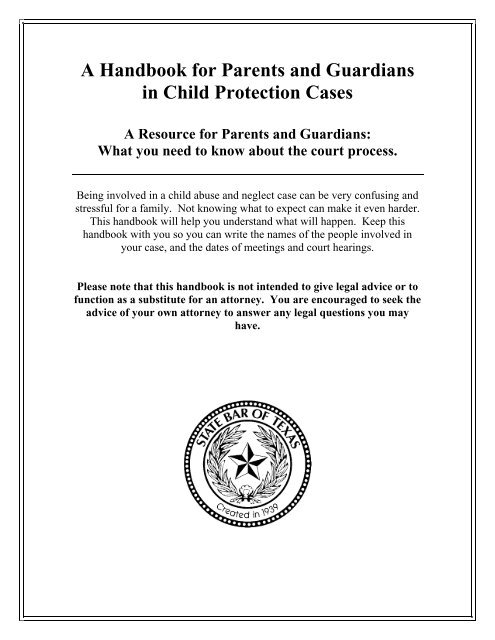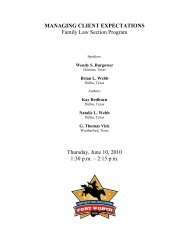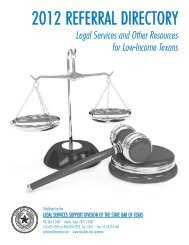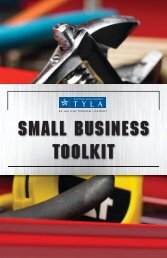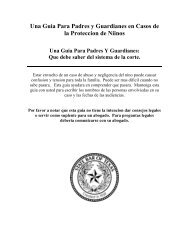A Handbook for Parents and Guardians in Child Protection Cases
A Handbook for Parents and Guardians in Child Protection Cases
A Handbook for Parents and Guardians in Child Protection Cases
- No tags were found...
You also want an ePaper? Increase the reach of your titles
YUMPU automatically turns print PDFs into web optimized ePapers that Google loves.
A <strong>H<strong>and</strong>book</strong> <strong>for</strong> <strong>Parents</strong> <strong>and</strong> <strong>Guardians</strong><strong>in</strong> <strong>Child</strong> <strong>Protection</strong> <strong>Cases</strong>A Resource <strong>for</strong> <strong>Parents</strong> <strong>and</strong> <strong>Guardians</strong>:What you need to know about the court process.Be<strong>in</strong>g <strong>in</strong>volved <strong>in</strong> a child abuse <strong>and</strong> neglect case can be very confus<strong>in</strong>g <strong>and</strong>stressful <strong>for</strong> a family. Not know<strong>in</strong>g what to expect can make it even harder.This h<strong>and</strong>book will help you underst<strong>and</strong> what will happen. Keep thish<strong>and</strong>book with you so you can write the names of the people <strong>in</strong>volved <strong>in</strong>your case, <strong>and</strong> the dates of meet<strong>in</strong>gs <strong>and</strong> court hear<strong>in</strong>gs.Please note that this h<strong>and</strong>book is not <strong>in</strong>tended to give legal advice or tofunction as a substitute <strong>for</strong> an attorney. You are encouraged to seek theadvice of your own attorney to answer any legal questions you mayhave.
What is CPS?<strong>Child</strong> Protective Services (CPS) is a part of the Texas Department of Family <strong>and</strong>Protective Services (FPS), a State Agency set up by law to make sure children are SAFEAT ALL TIMES. If children are not treated <strong>in</strong> a SAFE manner, all citizens <strong>in</strong> thecommunity MUST report unsafe activity by call<strong>in</strong>g 1-800-252-5400.A report was received say<strong>in</strong>g that your child was not SAFE. In<strong>for</strong>mation about thereason <strong>for</strong> the removal of your child is outl<strong>in</strong>ed <strong>in</strong> a paper called a Notification <strong>for</strong>Removal, left at your home. The <strong>Child</strong> Protective Services (CPS) caseworker from FPSmay also expla<strong>in</strong> why your child was removed from your care.The Next StepIf you disagree with the caseworker <strong>and</strong> the reason <strong>for</strong> removal of your child, you willhave a chance to expla<strong>in</strong> your side to a judge soon after the removal of your child.This h<strong>and</strong>book provides a basic guide to what happens when you <strong>and</strong> your child are<strong>in</strong>volved <strong>in</strong> a CPS case.Why Should You Talk to the Judge?To give the parties <strong>and</strong> the court your explanation of the events that brought your child<strong>in</strong>to foster care. It is important to remember that you may speak with the judge onlydur<strong>in</strong>g court hear<strong>in</strong>gs. You may not meet with the judge privately outside of court.The purpose of the <strong>Child</strong> <strong>Protection</strong> Court is to keep children safe <strong>and</strong> to help familiescreate a safe home <strong>for</strong> their children. The <strong>Child</strong> <strong>Protection</strong> Court is not designed topunish parents.The Judge can require you <strong>and</strong> your family to get help. The Judge also can order thatyour child be temporarily placed <strong>in</strong> the custody of <strong>Child</strong> Protective Services (CPS). Thismeans that, <strong>for</strong> the time be<strong>in</strong>g, CPS is legally responsible <strong>for</strong> your child <strong>and</strong>, with theapproval of the <strong>Child</strong> <strong>Protection</strong> Court, can make decisions about where your childshould live <strong>and</strong> what you need to do to have your child returned to you.The same problems that brought you to the <strong>Child</strong> <strong>Protection</strong> Court could result <strong>in</strong>crim<strong>in</strong>al charges aga<strong>in</strong>st you, your partner, or someone else <strong>in</strong> your family. In that case,you may have to go to another court <strong>and</strong> see another judge. This h<strong>and</strong>book does not dealwith crim<strong>in</strong>al cases. It is about civil proceed<strong>in</strong>gs (meet<strong>in</strong>gs <strong>and</strong> hear<strong>in</strong>gs) <strong>in</strong> the <strong>Child</strong><strong>Protection</strong> Court. Anyth<strong>in</strong>g you say <strong>in</strong> <strong>Child</strong> <strong>Protection</strong> Court may be used aga<strong>in</strong>st you <strong>in</strong>a crim<strong>in</strong>al case. If crim<strong>in</strong>al charges have been filed aga<strong>in</strong>st you, or you th<strong>in</strong>k they mightbe, you should talk to an attorney.
- Stay <strong>in</strong> touch with your attorney <strong>and</strong> your caseworker. Be sure they always havea current address <strong>and</strong> telephone number <strong>for</strong> you.- Th<strong>in</strong>gs move very quickly <strong>in</strong> child abuse <strong>and</strong> neglect cases. Be sure that youknow what you are supposed to do <strong>and</strong> when, <strong>and</strong> then do it. It could make thedifference <strong>in</strong> whether your child is returned to you.Who Will Be Involved <strong>in</strong> Your Case?CPS CaseworkerWhen your child is removed from your home, you will be given a notice of removal <strong>and</strong>the name <strong>and</strong> phone number of the CPS <strong>in</strong>vestigative caseworker. After approximatelytwo to three weeks, your <strong>in</strong>vestigative worker will transfer the case to anothercaseworker. The caseworker will:- Contact you to give you more <strong>in</strong><strong>for</strong>mation <strong>and</strong> ask you some questions;- Visit your child regularly;- Help you underst<strong>and</strong> the problems that brought you to court, <strong>and</strong>- Help you work on your service plan, which lists the steps you must take to haveyour child returned to you.If you do not hear from your CPS caseworker <strong>for</strong> a while, or if you have questions orproblems, call him or her.Your CPS caseworker’s name, address, <strong>and</strong> phone number are:Name:__________________________________________________________________Address:________________________________________________________________Phone: _________________________________________________________________Best time to call: _________________________________________________________Supervisor:______________________________________________________________Your child’s CPS caseworker, if different, is:Name:__________________________________________________________________
Address:________________________________________________________________Phone:_________________________________________________________________Best time to call:_________________________________________________________Supervisor:______________________________________________________________Your AttorneyWhen you go to Court, the Judge will ask if you have an attorney. You have the right toan attorney. If you cannot af<strong>for</strong>d to pay <strong>for</strong> an attorney, <strong>and</strong> CPS is seek<strong>in</strong>g to term<strong>in</strong>ateyour parental rights, you may ask the judge to appo<strong>in</strong>t one <strong>for</strong> you. Your attorney should:- Talk with you be<strong>for</strong>e every hear<strong>in</strong>g;- Speak <strong>for</strong> you <strong>in</strong> court;- Help you underst<strong>and</strong> your rights;- Tell you about the hear<strong>in</strong>gs you will attend; <strong>and</strong>- Tell you what to expect at each hear<strong>in</strong>g.If you do not hear from your Attorney <strong>for</strong> a while, or if you have questions or problems,call him or her. It is up to you to make sure your attorney can f<strong>in</strong>d you.Your Attorney’s name, address, <strong>and</strong> phone number are:Name:__________________________________________________________________Address:________________________________________________________________Phone:_________________________________________________________________Best time to call:_________________________________________________________Th<strong>in</strong>gs I want to discuss or ask about:________________________________________________________________________________________________________________________________________________________________________________________________________________________________________________________________________________________________
The Attorney <strong>for</strong> CPS<strong>Child</strong> Protective Services (CPS) also has an attorney. The Attorney <strong>for</strong> CPS representsCPS <strong>in</strong> court, <strong>and</strong> must prove why your child should be <strong>in</strong> CPS custody now.CPS Attorney’s Name:_____________________________________________________Your <strong>Child</strong>’s Attorney – the Attorney ad litem (AAL)Your child will have an attorney appo<strong>in</strong>ted by the Court. This attorney is called anattorney ad litem (AAL). The attorney ad litem’s job is to meet with your child <strong>and</strong> actas an advocate on behalf of your child. Often the attorney ad litem also serves as theGuardian ad litem (GAL) <strong>for</strong> your child.Attorney ad litem’s Name:__________________________________________________Phone: _________________________________________________________________The Court Appo<strong>in</strong>ted Special Advocate (CASA)The Judge may also appo<strong>in</strong>t a Court Appo<strong>in</strong>ted Special Advocate. The <strong>Child</strong> Advocate isa tra<strong>in</strong>ed volunteer who will meet with you <strong>and</strong> your child, as well as others <strong>in</strong>volved <strong>in</strong>this case. The <strong>Child</strong> Advocate reports to the Court about how your child is do<strong>in</strong>g <strong>and</strong>what they feel is <strong>in</strong> your child’s best <strong>in</strong>terest. Sometimes the <strong>Child</strong> Advocate may becalled a Guardian ad litem (GAL).CASA Volunteer’s Name: _________________________________________________Supervisor:_____________________________________________________________Phone:_________________________________________________________________Mediation / Family Group ConferenceDur<strong>in</strong>g the case, the Judge may order that your case be sent to mediation or family groupconference. Mediation is a meet<strong>in</strong>g between you, your attorney, CPS, <strong>and</strong> their attorneyto try to reach an agreement <strong>in</strong>stead of go<strong>in</strong>g to court. Mediators are <strong>in</strong>dependent, neutral<strong>in</strong>dividuals who have been specially tra<strong>in</strong>ed to help people work out differences.Mediation is not a court hear<strong>in</strong>g. If you wish to use a mediator to help with your case,ask if mediation is available <strong>in</strong> your area.Mediation In<strong>for</strong>mation:Time & Date: __________________________________________________________Place:_________________________________________________________________
Th<strong>in</strong>gs I want to discuss or ask about:______________________________________________________________________________________________________________________________________________________________________________________________________________________________________________________________________________When Will You Have to Go to Court?You may be asked to attend several court hear<strong>in</strong>gs <strong>and</strong> other meet<strong>in</strong>gs so that the Judge<strong>and</strong> others can listen to all sides <strong>and</strong> decide how to help your family. Most child abuse<strong>and</strong> neglect cases have at least eight different court hear<strong>in</strong>gs <strong>and</strong> meet<strong>in</strong>gs dur<strong>in</strong>g the firstyear:- Emergency Hear<strong>in</strong>g- Adversary Hear<strong>in</strong>g (Show Cause) or Mediation- Initial Permanency Plann<strong>in</strong>g Team Meet<strong>in</strong>g or PPT- Status Hear<strong>in</strong>g- Initial Permanency Hear<strong>in</strong>g- Additional PPT meet<strong>in</strong>gs- Permanency Hear<strong>in</strong>g- F<strong>in</strong>al Hear<strong>in</strong>g (Trial)It is important <strong>for</strong> you to be on time <strong>for</strong> all these hear<strong>in</strong>gs. If you are not present <strong>in</strong>court at the time a hear<strong>in</strong>g or trial is scheduled, the proceed<strong>in</strong>g may beg<strong>in</strong> withoutyou.Each court hear<strong>in</strong>g <strong>and</strong> meet<strong>in</strong>g has a different purpose. They are all described <strong>in</strong> thish<strong>and</strong>book, so that you know what to expect at each hear<strong>in</strong>g or meet<strong>in</strong>g, when <strong>and</strong> whereit will be held, <strong>and</strong> why it is important <strong>for</strong> you to attend.Remember, the purpose of the <strong>Child</strong> <strong>Protection</strong> Court is to keep children safe <strong>and</strong> to helpfamilies create a safe home <strong>for</strong> their children. If you do not underst<strong>and</strong> the purpose ofany hear<strong>in</strong>g you should ask an attorney. If you cannot af<strong>for</strong>d an attorney it isimportant that you ask the Judge to appo<strong>in</strong>t one <strong>for</strong> you.The Emergency Hear<strong>in</strong>gIf your child has been removed from your home without a court order, the EmergencyHear<strong>in</strong>g will be held with<strong>in</strong> one work<strong>in</strong>g day of when the petition is filed <strong>in</strong> <strong>Child</strong><strong>Protection</strong> Court, <strong>and</strong> may take place without you be<strong>in</strong>g there.
This hear<strong>in</strong>g gives the Judge the chance to f<strong>in</strong>d out why your child was removed fromyour home. At the Emergency Hear<strong>in</strong>g, the Judge will decide if your child should stay <strong>in</strong>the temporary custody of CPS until the adversary hear<strong>in</strong>g.The attorney <strong>for</strong> CPS will present <strong>in</strong><strong>for</strong>mation about the case to the Judge. In<strong>for</strong>mationwill <strong>in</strong>clude the allegations made <strong>and</strong> what the <strong>in</strong>vestigation by CPS has revealed so far.CPS will also let the Judge know what actions have been taken to f<strong>in</strong>d a placement <strong>for</strong>the child, other than foster care.The Adversary Hear<strong>in</strong>g (Show Cause)This hear<strong>in</strong>g will be held no later that the 14 th day after the date the child was removed.The purpose of this hear<strong>in</strong>g is to determ<strong>in</strong>e whether the child’s emergency removal wasproper <strong>and</strong> to get temporary orders <strong>for</strong> the protection of the child until the case is over.The Judge may decide to return your child to you, or to place the child with a familymember, a family friend or another appropriate adult who is will<strong>in</strong>g to help <strong>and</strong> cooperate<strong>in</strong> this matter. You should come to the hear<strong>in</strong>g with the names, addresses <strong>and</strong> telephonenumbers of people who might be able to keep your child temporarily.F<strong>in</strong>ally, the Judge may decide that <strong>for</strong> the safety <strong>and</strong> protection of your child it would bebest that your child rema<strong>in</strong> <strong>in</strong> the care of CPS.This hear<strong>in</strong>g is your chance to expla<strong>in</strong> the situation from your po<strong>in</strong>t of view <strong>and</strong> let theJudge know how you <strong>in</strong>tend to protect your child now <strong>and</strong> <strong>in</strong> the future.The time <strong>and</strong> place of your Adversary Hear<strong>in</strong>g (Show Cause) is:Time & Date:____________________________________________________________Place:__________________________________________________________________Th<strong>in</strong>gs I want to discuss or ask about:________________________________________________________________________________________________________________________________________________________________________________________________________________________________________________________________________________________________
Permanency Plann<strong>in</strong>g Team Meet<strong>in</strong>gsThe Permanency Plann<strong>in</strong>g Team staff<strong>in</strong>g is usually held between 30 <strong>and</strong> 45 days after theremoval of your child from your home <strong>and</strong> aga<strong>in</strong> <strong>in</strong> the fifth, n<strong>in</strong>th <strong>and</strong> thirteenth months.Although this is not a court hear<strong>in</strong>g <strong>and</strong> the judge will not be present, all the people whoare <strong>in</strong>volved <strong>in</strong> the case, <strong>in</strong>clud<strong>in</strong>g the attorneys, the child if over 12 years of age, fosterparents, parents, CPS staff <strong>and</strong> other caretakers can be there. Family members who are<strong>in</strong>terested <strong>in</strong> your child are also encouraged to attend.At the first PPT staff<strong>in</strong>g a “service plan” will be developed <strong>and</strong> discussed. The serviceplan will <strong>in</strong>clude the goal <strong>for</strong> the child that may be:- Reunification with parent(s);- Term<strong>in</strong>ation of parents’ rights to the child;- Placement of child with relatives;- Placement of child <strong>in</strong> foster care; or- Adoptive placement.The purpose of this meet<strong>in</strong>g is to talk about why your child was removed from yourhome. The other purpose of this meet<strong>in</strong>g is to come up with a service plan <strong>for</strong> your child<strong>and</strong> your family that will help get your family together aga<strong>in</strong>, or whatever is best <strong>for</strong> yourchild. That service plan will be presented to the <strong>Child</strong> <strong>Protection</strong> Court. Be aware thatthe plan may change, but it will rema<strong>in</strong> <strong>in</strong> effect until amended by CPS <strong>and</strong> approved bythe Court.It is very important that you attend the PPT meet<strong>in</strong>gs, so that your ideas about what isbest <strong>for</strong> your family <strong>and</strong> what can be done to make sure your child rema<strong>in</strong>s safe can beheard. You will receive a letter tell<strong>in</strong>g you about PPT meet<strong>in</strong>gs: the date, time <strong>and</strong> place.You may also call your CPS caseworker to f<strong>in</strong>d out about your child’s next PPT meet<strong>in</strong>g.The time <strong>and</strong> place of your first PPT <strong>and</strong> Service Plan meet<strong>in</strong>g is:Time & Date:____________________________________________________________Place:___________________________________________________________________Th<strong>in</strong>gs I want to discuss or ask about:________________________________________________________________________________________________________________________________________________________________________________________________________________________________________________________________________________________________
The Status Hear<strong>in</strong>gYou have the right to a hear<strong>in</strong>g be<strong>for</strong>e a Judge to discuss the service plan prepared byCPS. This hear<strong>in</strong>g is called the Status Hear<strong>in</strong>g. It will be held with<strong>in</strong> 60 days of whenyour child was ordered <strong>in</strong>to the temporary care of CPS.The purpose of the Status Hear<strong>in</strong>g is to make sure that there is a Service Plan <strong>in</strong> place <strong>for</strong>your child, that you are aware of this Service Plan <strong>and</strong> all of its contents, <strong>and</strong> that youunderst<strong>and</strong> that you must complete all of the requests made <strong>in</strong> this Service Plan (whichthe Judge adopts) <strong>in</strong> order to have your child returned to you. At this hear<strong>in</strong>g the Judgemay also ask about your current compliance with this plan.You will be warned that unless you do what is asked of you <strong>in</strong> the service plan, yourrights as a parent may be restricted or term<strong>in</strong>ated.It is very important that you attend the Status Hear<strong>in</strong>g.The time <strong>and</strong> place of your Status Hear<strong>in</strong>g is:Time & Date:____________________________________________________________Place:__________________________________________________________________Th<strong>in</strong>gs I want to discuss or ask about:________________________________________________________________________________________________________________________________________________________________________________________________________________________________________________________________________________________________The Permanency Hear<strong>in</strong>gThe <strong>in</strong>itial permanency hear<strong>in</strong>g must be held no later than 180 days after CPS is named astemporary manag<strong>in</strong>g conservator of your child.The purpose of the Permanency Hear<strong>in</strong>g is to evaluate the Permanency Plan <strong>for</strong> the childto ensure that a f<strong>in</strong>al order consistent with that permanency plan is rendered be<strong>for</strong>e thedate <strong>for</strong> dismissal of the case.The Judge will review your case to make sure that the Service Plan is be<strong>in</strong>g followed.The Judge will check to make sure you are do<strong>in</strong>g what is ordered <strong>in</strong> the plan. The Judgewill check to make sure the CPS Caseworker <strong>and</strong> others are do<strong>in</strong>g what is ordered <strong>in</strong> the
plan. If everyone agrees that the Service Plan needs to be changed, the Judge may orderthose changes.You will be told <strong>in</strong> court that your parental <strong>and</strong> custodial rights may be subject torestriction or term<strong>in</strong>ation unless you are will<strong>in</strong>g <strong>and</strong> able to provide your child with a safeenvironment.If the Judge believes your child will be safe, <strong>and</strong> that it is <strong>in</strong> your child’s best <strong>in</strong>terest tobe returned to you at this time, the judge can decide to return your child to you.The Judge may also decide that your child needs cont<strong>in</strong>ued substitute care <strong>and</strong> if thecurrent placement is appropriate, <strong>and</strong> whether other plans or services are needed to meetyour child’s special needs.At this hear<strong>in</strong>g it will be decided what plans, services, or other temporary orders arenecessary to ensure f<strong>in</strong>al orders are rendered prior to the dismissal deadl<strong>in</strong>e.At the close of the hear<strong>in</strong>g, the Judge may set a dismissal date <strong>and</strong> give notice <strong>in</strong> opencourt to all parties of that date, the date of the next Permanency Hear<strong>in</strong>g, <strong>and</strong> the date thecase is set <strong>for</strong> trial.The time <strong>and</strong> place of your Initial Permanency Hear<strong>in</strong>g is:Time & Date:____________________________________________________________Place:__________________________________________________________________Th<strong>in</strong>gs I want to discuss or ask about:________________________________________________________________________________________________________________________________________________________________________________________________________________________________________________________________________________________________Subsequent Permanency Hear<strong>in</strong>gsIf the Judge decides at your first Permanency Hear<strong>in</strong>g that your child cannot be safelyreturned home, another Permanency Hear<strong>in</strong>g will be held to allow you to cont<strong>in</strong>ue withservices <strong>and</strong> determ<strong>in</strong>e the progress you have made, or decide if your child’s plan shouldbe changed to adoption, or some other permanent arrangement outside of your home.Subsequent Permanency Hear<strong>in</strong>gs must be held no later than every 120 days until entryof a f<strong>in</strong>al order. The court can hold the hear<strong>in</strong>g at an earlier date.
The requirements <strong>and</strong> procedures are the same as <strong>for</strong> the <strong>in</strong>itial permanency hear<strong>in</strong>g.The time <strong>and</strong> place of your Subsequent Permanency Hear<strong>in</strong>g is:Time & Date:____________________________________________________________Place:__________________________________________________________________Th<strong>in</strong>gs I want to discuss or ask about:________________________________________________________________________________________________________________________________________________________________________________________________________________________________________________________________________________________________F<strong>in</strong>al Hear<strong>in</strong>g (Trial)The court must enter a f<strong>in</strong>al order be<strong>for</strong>e the first Monday after the first anniversary ofthe order appo<strong>in</strong>t<strong>in</strong>g CPS temporary manag<strong>in</strong>g conservator, unless on or be<strong>for</strong>e that datethe court has granted an extension of no more than 180 days.A f<strong>in</strong>al order is one that:- Requires that the child be returned to the parents;- Names a relative of the child or another person as the child’s manag<strong>in</strong>gconservator;- Without term<strong>in</strong>at<strong>in</strong>g the parent-child relationship, appo<strong>in</strong>ts CPS as the manag<strong>in</strong>gconservator of the child; or- Term<strong>in</strong>ates the parent-child relationship <strong>and</strong> appo<strong>in</strong>ts a relative of the child,another suitable person, or CPS as the manag<strong>in</strong>g conservator.For all F<strong>in</strong>al Hear<strong>in</strong>gs, testimony <strong>and</strong> evidence will be offered regard<strong>in</strong>g your child’s best<strong>in</strong>terest.The time <strong>and</strong> place of the F<strong>in</strong>al Hear<strong>in</strong>g (Trial) is:Time & Date:____________________________________________________________Place:__________________________________________________________________
Th<strong>in</strong>gs I want to discuss or ask about:________________________________________________________________________________________________________________________________________________________________________________________________________________________________________________________________________________________________Special In<strong>for</strong>mation <strong>for</strong> FATHERSEstablish<strong>in</strong>g PaternityAcknowledg<strong>in</strong>g paternity <strong>for</strong> a child born to unmarried parents is very important. UnderTexas law, when a father <strong>and</strong> mother sign an Acknowledgment of Paternity <strong>and</strong> the courtaccepts these documents, the father becomes the “legal” father. Paternity means thatfatherhood has been legally established <strong>and</strong> the father may be ordered to pay childsupport. A registry of paternity is established <strong>in</strong> the bureau of Vital Statistics.A man who wants to be notified of a proceed<strong>in</strong>g <strong>for</strong> the adoption of or the term<strong>in</strong>ation ofparental rights regard<strong>in</strong>g his child that he may have fathered may register with theregistry of paternity:- Be<strong>for</strong>e the birth of the child, but- Not later that the 31 st day after the date of the birth of the child.If the relationship between the father <strong>and</strong> the child has been established under anotherlaw, or if the man beg<strong>in</strong>s a proceed<strong>in</strong>g to adjudicate his paternity be<strong>for</strong>e the court hasterm<strong>in</strong>ated his parental rights, then the man is entitled to notice of the proceed<strong>in</strong>gregardless of whether he registers with the registry of paternity.Notice of a proceed<strong>in</strong>g to adopt or to term<strong>in</strong>ate parental rights regard<strong>in</strong>g a child must begiven to you if you have timely registered with regard to that child.Where can you get an “Acknowledgment of Paternity” <strong>for</strong>m?Acknowledgment of Paternity <strong>for</strong>ms are available at the hospital, the local registrar, the<strong>Child</strong> Support Office, <strong>and</strong> the State Bureau of Vital Statistics at (512) 458-7393.What if the father th<strong>in</strong>ks that the child is his, but the mother won’t sign theAcknowledgment of Paternity with him?
The father can go to the Attorney General’s office <strong>and</strong> open a case, or he can consult aprivate attorney.What if the father does not believe the child is his?He can ask <strong>for</strong> paternity test<strong>in</strong>g. A court will look at the results of the paternity test <strong>and</strong>at other evidence that would l<strong>in</strong>k the father to the child. If the tests do show that the manis the biological father of the child, he may be ordered to repay the costs of the tests <strong>and</strong>may be ordered to pay child support.
<strong>Child</strong> is removedfrom the homeAdversaryHear<strong>in</strong>gOccurs with<strong>in</strong> 14days of removal14 days1 dayEmergency Hear<strong>in</strong>gOccurs with<strong>in</strong> one work<strong>in</strong>gday of removalInitial PermanencyHear<strong>in</strong>gOccurs with<strong>in</strong> 180days of date of ordergiv<strong>in</strong>g CPS TMC180 days60 days Status Hear<strong>in</strong>gOccurs with<strong>in</strong> 60 days oftemporary order giv<strong>in</strong>g CPSTMCPermanency Hear<strong>in</strong>g(s)Occur every 120 days untilf<strong>in</strong>al orderF<strong>in</strong>al Merits Hear<strong>in</strong>g(Trial)F<strong>in</strong>al order requiredbe<strong>for</strong>e Monday next afterfirst anniversary of ordergiv<strong>in</strong>g CPS TMCPlacement ReviewHear<strong>in</strong>g(s)Occur every 180 days


